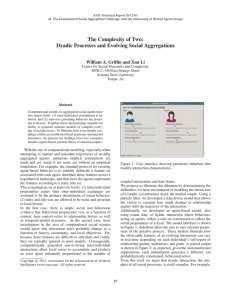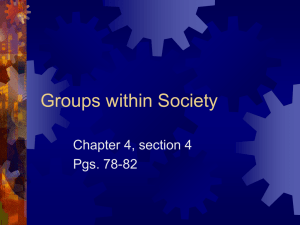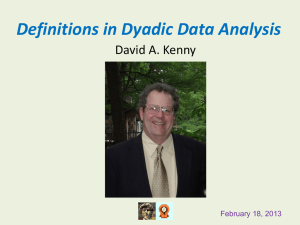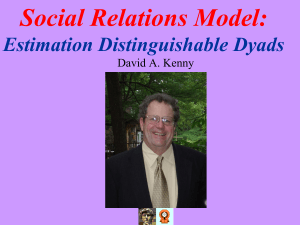Status and Intergroup Perception
advertisement
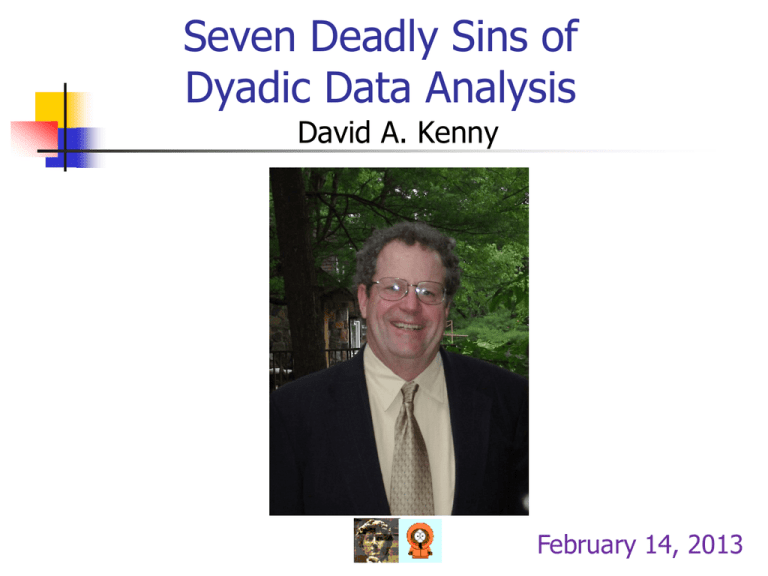
Seven Deadly Sins of Dyadic Data Analysis David A. Kenny February 14, 2013 Introduction Many of the sins to be described were common because we did not have the proper dyadic tools. Now that we have those tools, we need to avoid the following practices. Moreover, several of the practices are acceptable IF proper empirical justification is given. 2 It Would Help to Know Basic definitions in dyadic data analysis It would also help to know about the actorpartner interdependence model (APIM) and nonindependence. Links definitions APIM nonindependence 3 1. Assuming that dyad members are distinguishable without testing whether such an assumption is warranted Most common and problematic case: Separate analyses for men and women in heterosexual dyads Perform a test of distinguishability. Even when that test is significant, it does not mean that all parameters differ across the distinguishing variable. Remember: Parsimony is valued in science and that estimating a single model results in greater precision and power. 4 2. Assuming that a statistically significant effect for one member of the dyad but not significant for the other implies that the effect varies across members Statistical significance of each parameter tests whether the parameter differs from zero. A path of .3 may be significant for men and the path of .1 is not be significant for women. However, it still may be that .3 does not differ significantly from .1. We need to test the interaction with the distinguishing variable (e.g., gender) to draw this conclusion. 5 3. Summing or averaging the scores for two members of the dyad without any empirical justification It is acceptable to sum or average the dyad members’ scores if they are highly correlated though sometimes it might be better to use a common fate model. To sum predictors, it must be the case that the actor effect = partner effect: Y1 = aX1 + pX2 + E1 If a = p then Y1 = 2a(X1+X2)/2 + E1 It is acceptable to sum the outcome if the ALL the predictors are between-dyads because a between-dyads predictor can explain only between dyads variation. 6 4. Using discrepancy score as a predictor without controlling for the main effects Discrepancy scores or lX1 – X2l are really interactions and need to control for the main effects before considering whether an interaction (e.g., similarity) has an effect. Also a difference score or X1 – X2 is confounded with (or are a linear combination of) actor and partner! You can use if a difference score as predictor if actor and partner effects are of equal and opposite signs (a + p = 0). 7 5. Assuming that one member causes the other without realizing that the other has influence Sometimes called pseudounilaterality Examples Human Development: Parent to child Social Psychology: Confederates Health Research: Having only the caretaker determine the outcomes of the patient One needs to allow bidirectional influence either using the actor-partner interdependence or the mutual influence model. 8 6. Not including partner characteristics as predictors Researchers sometimes say that their theory does not make predictions about partner effects, and so they exclude them. If dyad might be interdependent, analysts should at least examine partner effects before dropping them. If there are partner effects, the actor effects may be biased! If no partner effects, they can be dropped. Less commonly, actor characteristics are ignored. 9 7. Treating individual as the unit of analysis and ignoring dyad Becoming less common but still occurs Is permissible if the data are independent on the outcome variable. Still include partner characteristics as possible predictors. 10 Conclusion Although the focus is on poor data analysis, I have tried to show what needs to be done instead. Many of these practices are acceptable IF first preliminary analyses are conducted. Readings: Chapter 15, pages 421-424 in Dyadic Data Analysis by Kenny, Kashy, and Cook Thanks to Deborah Kashy for help in preparing these slides! 11




